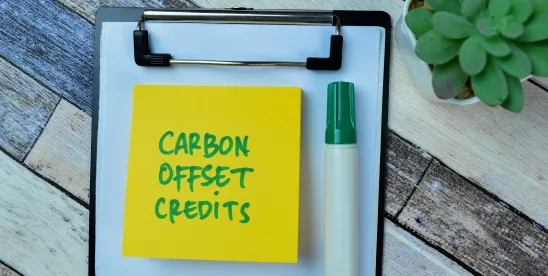Taylor Swift’s “Eras Tour” was one of the highest grossing music tours of all time with approximate proceeds exceeding US$1 billion. While this is a monumental feat, Taylor Swift also gained negative attention during the tour for her liberal use of private jets. It has been reported, however, that she, like many businesses across the world, buys carbon offsets to compensate for her emissions.
Carbon offsets, otherwise known as carbon credits or emissions units, can be bought to offset emissions made by a person or business. Carbon credits are most typically used to offset greenhouse gas (GHG) emissions. If a business buys enough carbon credits to offset all its GHG emissions, then that business is said to achieve “net zero” (i.e. the sum of all its emissions and offsets are zero).
There are multiple international schemes under which carbon credits can be purchased, and in some jurisdictions (such as the European Union), their trade is connected to a carbon tax. One of the world’s most widely used schemes is the Verified Carbon Standard (VCS) Program, which is operated by Verra, a nonprofit organisation headquartered in Washington, D.C.
Domestically, Australian businesses tend to focus on producing, selling and buying Australian Carbon Credit Units (ACCUs), often in connection with the ACCU scheme (ACCU Scheme).
Separately, Australia has an emissions reduction safeguard mechanism (Safeguard Mechanism) that was established under the National Greenhouse and Energy Reporting Act 2007 (NGER Act). Under the Safeguard Mechanism, certain designated large facilities must ensure that their net emissions number does not exceed their baseline emissions number at the end of each monitoring period. The Safeguard Mechanism applies to all industrial facilities emitting more than 100,000 tonnes of carbon dioxide equivalent per year. This captures a number of large mining, oil and gas production, manufacturing, transport and waste facilities.
This alert will consider:
- The ACCU Scheme and Australia’s voluntary carbon market.
- Reforms to the Safeguard Mechanism and the issue of Safeguard Mechanism credit units (SMCs).
- Australia’s financial services regulatory regime that underpins the issue and trading of ACCUs, Eligible International Emissions Units (EIEUs) and other emissions units.
- How reporting entities may use ACCUs to disclose in accordance with the sustainability reporting standards.
WHAT IS AN ACCU?
An ACCU is a unit issued by the Clean Energy Regulator (CER), which represents one tonne of carbon dioxide equivalent net abatement by a project. This can be achieved through emissions reduction or carbon sequestration.
There are two types of ACCUs: Kyoto ACCUs and non-Kyoto ACCUs. The CER issues an ACCU as one of the two types, depending on whether the related carbon abatement is eligible to be used to meet Australia’s climate change targets under the Kyoto Protocol.
ACCUs are a key component of Australia’s carbon market. The CER estimates around 20 million ACCUs will be issued in 2024, up from 17.2 million issued the previous year.
THE ACCU SCHEME
Australia operates a voluntary carbon market through the ACCU Scheme (formerly known as the Emissions Reduction Fund).
The ACCU Scheme offers businesses the opportunity to run projects in Australia that avoid the release of GHG emissions or remove and sequester carbon from the atmosphere. There are a number of requirements that a project must satisfy to be classified as an eligible offsets project, allowing for the issue of an ACCU.
Once ACCUs are issued, they can be sold to generate income, either to the Australian Government (through a carbon abatement contract) or other companies or private buyers in the secondary market to help offset their emissions.
The ACCU Scheme is enacted through the Carbon Credits (Carbon Farming Initiative) Act 2011 (Cth) and the Carbon Credits (Carbon Farming Initiative) Rule 2015 and administered by the CER. The CER is an Australian Government body.
ACCU PROPERTY RIGHTS
An ACCU is personal property. Accordingly, the registered holder of an ACCU is the legal owner and can pass good title to the ACCU to another person, business or the government. ACCUs can be sold via fixed-price commercial agreements or on the spot market at the prevailing market price. As at 18 June 2024, the generic spot price per ACCU was AU$34.25.1
Given worldwide efforts to reduce carbon emissions, both the government and companies seeking to reduce their carbon footprint are in the market to purchase ACCUs.
Kyoto ACCUs issued in relation to an eligible offsets project can be sold to the Commonwealth under a carbon abatement contract. In that circumstance, a project proponent enters into a carbon abatement contract with the CER.
Alternatively, ACCUs that have not been surrendered, cancelled or relinquished can be traded. Purchased ACCUs can be used to achieve climate goals in the short term while an organisation is implementing longer-term operational practices to reduce emissions.
THE AUSTRALIAN CARBON EXCHANGE
To facilitate trading in ACCUs, the CER is in the process of developing the Australian Carbon Exchange. The CER is working together with the Australian Securities Exchange to develop an appropriate and effective model. The project is expected to increase the accessibility of trading ACCUs and any new units and certificates that are introduced, such as SMCs. This will make participating in Australia’s carbon markets both cheaper and easier. Furthermore, this investment into the infrastructure of the ACCU market will play a crucial role in Australia meeting its 2030 and 2050 emissions reduction targets.
A key component of the project will be the new Unit & Certificate Register, which will replace CER’s current register. The CER has entered into a contract with Trovio Group to develop the register. They are aiming to have the register operating by mid-2025.
Whilst the launch of Australia’s Carbon Exchange is still dependent on a range of regulatory and other approvals being granted, we expect there to be an increase in trading interest from businesses and investors following launch between late 2024 to early 2025.
SAFEGUARD MECHANISM REFORMS
The Safeguard Mechanism reforms set out legislated targets, known as baselines, for certain designated large facilities (Safeguard Facilities). These baselines are intended to help achieve Australia’s emission reduction targets of 43% below 2005 levels by 2030 and net zero by 2050.
The Safeguard Facilities capture Australia’s highest GHG-emitting facilities. For the 2022–2023 reporting year, there were 219 Safeguard Facilities operating across mining, oil and gas production, manufacturing, transport, waste and electricity.2
The Safeguard Mechanism reforms commenced on 1 July 2023 under the Safeguard Mechanism (Crediting) Amendment Act 2023, which implements reforms to the Safeguard Mechanism by amending the NGER Act and other legislation.
These reforms will allow the CER to issue SMCs from January 2025 to Safeguard Facilities whose net emissions are below their baselines. The regime has been designed to incentivise Safeguard Facilities to reduce their emissions beyond their baselines.
Safeguard Facilities that earn SMCs can sell them to other Safeguard Facilities, surrender them to stay within their baseline or retain them for future use until 2030. One SMC represents one tonne of carbon dioxide-equivalent emissions below a facility’s baseline.
SMCs are a type of EIEU, which in turn is a certain type of emission unit issued under mechanisms established by the Kyoto rules. EIEUs are defined under the Australian National Registry of Emissions Units Act 2011.
The Australian Securities and Investments Commission (ASIC) is proposing to update regulatory guidance to address the implications of the Safeguard Mechanism reforms under the Corporations Act 2001 (Cth) (Corporations Act). ASIC issued ASIC Consultation Paper 378 in May 2024 and expects to issue updated guidance in the second half of this year.
AUSTRALIAN FINANCIAL SERVICES REGULATION
If you are interested in issuing, acquiring or trading ACCUs or EIEUs, it is important to understand Australia’s financial services regulatory regime.
ASIC refer to ACCUs and EIEUs as regulated emissions units, which are financial products under the Corporations Act. This means that if you provide a financial service in relation to either ACCUs or EIEUs, you may require an Australian financial services (AFS) licence.
You may be providing a financial service in relation to ACCUs or EIEUs if you:
- Issue ACCUs under a project registered under the ACCU Scheme.
- Provide a recommendation or an opinion in relation to investing in ACCUs or EIEUs.
- Operate a managed investment scheme and acquire ACCUs or EIEUs on behalf of scheme members.
- Hold ACCUs or EIEUs in trust for, or on behalf of, another person.
Not all activities associated with ACCUs and EIEUs will trigger the requirement to hold an AFS licence. Some exemptions do apply. You may be exempt from the requirement to hold an AFS licence in relation to ACCUs/EIEUs if you:
- Deal in ACCUs or EIEUs on your own behalf (i.e. you acquire ACCUs or EIEUs for your own use) or on behalf of a related body corporate.
- Provide technical advice or factual information about an offset project.
- Enter into a carbon abatement contract.
ACCUs and EIEUs are also commonly associated with other financial products, such as derivatives. For example, a sale-and-purchase agreement for ACCUs or EIEUs for delivery on a future date is likely to be a derivative. If a derivative is created over an ACCU, EIEU or any other emission unit, the derivative itself is likely to be a financial product regulated under the Corporations Act, even if the emission unit itself is not a financial product. Accordingly, an AFS licence is required to deal in derivatives and an AFS licence may also be required to provide advice on ACCUs, EIEUs and/or derivatives (depending on your activities).
Importantly, whilst Australia’s financial services regulatory regime specifies ACCUs and EIEUs as regulated emissions units, there are other types of emissions units that may be issued, acquired, held or disposed of outside Australia. For example, many Australian businesses hold emissions units issued by Verro as part of the VCS Program. These emissions units may still be considered a financial product, and you will need to consider whether you may be required to hold an AFS licence.
CLIMATE-RELATED FINANCIAL DISCLOSURES
Another important consideration for businesses that wish to trade in ACCUs (or other GHG emission offsets) is understanding how they fit into Australia’s proposed climate-related financial reporting regime.
As previously reported by K&L Gates, the Australian Government has now published the Treasury Laws Amendment (Financial Market Infrastructure and Other Measures) Bill 2024 (Draft Legislation). The Draft Legislation was read a second time on 15 May 2024 and follows the release of draft Australian Sustainability Reporting Standards – Disclosure of Climate-related Financial Information (Draft ASR Standards) from the Australian Accounting Standards Board, which were published on 23 October 2023 (as previously reported by K&L Gates).
If passed, the proposed provisions under the Draft Legislation will require certain reporting entities (under Chapter 2M of the Corporations Act) to prepare and lodge with ASIC annual “sustainability reports” as part of its annual financial statements. These annual sustainability reports will need to be prepared in compliance with the Draft ASR Standards.
Under Draft ASR Standards, paragraphs 33–37.1 (titled “Climate-related targets”), reporting entities must disclose “the quantitative and qualitative climate-related targets it has set”. For each GHG target that the reporting entity has set, it must disclose, amongst others, the following:
- Which GHGs are covered by that target.
- The planned use of “carbon credits” to offset GHG emissions to help the reporting entity to achieve that target.
Kyoto ACCUs and non-Kyoto ACCUs are currently proposed to be included in the definition of “carbon credits”; however, it is unclear how other types of emissions units may be referred to.
Under the Draft ASR Standards, reporting entities will also need to disclose:
- The type of carbon credits used.
- Whether the “underlying offset [of the carbon credit] will be nature-based or based on technological carbon removals”.
- Other factors which impact the integrity of the carbon credit, such as “assumptions regarding the permanence of the carbon offset”.
TAKEAWAYS
The use of carbon credits will increasingly become an important means by which Australian businesses can reduce their GHG emissions as they demonstrate progress towards their net-zero ambitions or commitments. In addition to this, the Safeguard Mechanism reforms will now motivate Australia’s largest GHG-emitting industrial facilities to find and implement abatement opportunities to address the decarbonisation challenge. Those that do not reduce their emissions beyond their baseline will be required to buy SMCs.
These developments mean Australia’s voluntary carbon market is becoming a rapidly growing marketplace, which will only be further enhanced by the introduction of the Australian Carbon Exchange.
If you are interested in issuing, acquiring or trading ACCUs, EIEUs or any other emissions units, it is important to be aware that unless an exemption applies, an AFS licence will generally be required.








 />i
/>i
